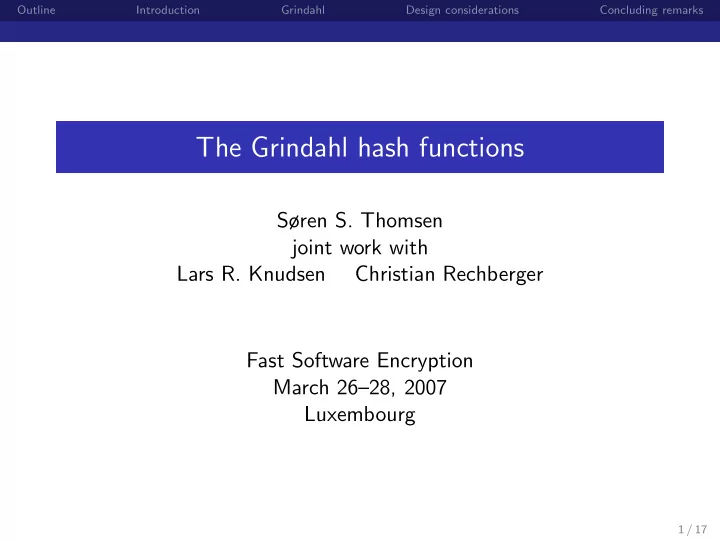

Outline Introduction Grindahl Design considerations Concluding remarks The Grindahl hash functions Søren S. Thomsen joint work with Lars R. Knudsen Christian Rechberger Fast Software Encryption March 26–28, 2007 Luxembourg 1 / 17
Outline Introduction Grindahl Design considerations Concluding remarks 1 Introduction 2 Grindahl 3 Design considerations 4 Concluding remarks 2 / 17
Outline Introduction Grindahl Design considerations Concluding remarks MD4-style hash functions Many hash functions; MD4, MD5, RIPE-MD, SHA-1, . . . n -bit output, n -bit state Simple (fast) state update Repeat many times 3 / 17
Outline Introduction Grindahl Design considerations Concluding remarks Attack methods Local collisions: Introduce difference “Undo” difference as quickly as possible (probabilistic) Small difference means behaviour is more predictable Success with high probability 4 / 17
Outline Introduction Grindahl Design considerations Concluding remarks Thoughts behind our design Ensure quick diffusion (in both directions) Limited control over differences (All) collision trails are wide Block cipher techniques 5 / 17
Outline Introduction Grindahl Design considerations Concluding remarks Grindahl-256 Based on Rijndael block cipher 256-bit output State: 4 × 13 matrix of bytes (initially all zero) SubBytes and MixColumns as in Rijndael ShiftRows rotates right by 1 , 2 , 4 , 10 positions 6 / 17
Outline Introduction Grindahl Design considerations Concluding remarks Grindahl-256: round function 4-byte message block replaces first state column New operation: AddConstant. Flips last bit of last byte Do one round: AddConstant, SubBytes, ShiftRows, MixColumns Round function a permutation → invertible 7 / 17
Outline Introduction Grindahl Design considerations Concluding remarks Grindahl-256: output After last message block, do 8 more (“blank”) rounds (permutation) Output right-most 8 columns 8 / 17
Outline Introduction Grindahl Design considerations Concluding remarks Grindahl-256: ShiftRows Why change ShiftRows? Improve diffusion speed Every state byte depends on every message byte after 4 rounds 9 / 17
Outline Introduction Grindahl Design considerations Concluding remarks How a message block affects the state Message injected: 10 / 17
Outline Introduction Grindahl Design considerations Concluding remarks How a message block affects the state After ShiftRows (1st round): 10 / 17
Outline Introduction Grindahl Design considerations Concluding remarks How a message block affects the state After MixColumns (1st round): 10 / 17
Outline Introduction Grindahl Design considerations Concluding remarks How a message block affects the state After ShiftRows (2nd round): 10 / 17
Outline Introduction Grindahl Design considerations Concluding remarks How a message block affects the state After MixColumns (2nd round): 10 / 17
Outline Introduction Grindahl Design considerations Concluding remarks How a message block affects the state After ShiftRows (3rd round): 10 / 17
Outline Introduction Grindahl Design considerations Concluding remarks How a message block affects the state After MixColumns (3rd round): 10 / 17
Outline Introduction Grindahl Design considerations Concluding remarks How a message block affects the state Wiping first column: 10 / 17
Outline Introduction Grindahl Design considerations Concluding remarks How a message block affects the state After ShiftRows (4th round): 10 / 17
Outline Introduction Grindahl Design considerations Concluding remarks How a message block affects the state After MixColumns (4th round): 10 / 17
Outline Introduction Grindahl Design considerations Concluding remarks Grindahl-256: AddConstant Why AddConstant? Without AddConstant: 13 equal columns invariant a a a a a a a a a a a a a b b b b b b b b b b b b b c c c c c c c c c c c c c d d d d d d d d d d d d d 11 / 17
Outline Introduction Grindahl Design considerations Concluding remarks Grindahl-256: blank rounds Why 8 blank rounds? 4 rounds required to make output depend on last block Security margin (Chicken-hash) 12 / 17
Outline Introduction Grindahl Design considerations Concluding remarks Grindahl-256: columns Why 13 columns? At least 10 columns, otherwise birthday attack Round function invertible → meet-in-the-middle Hence, (2nd) preimage below 2 n (claim 2 n / 2 ) (Chicken-hash again) 13 / 17
Outline Introduction Grindahl Design considerations Concluding remarks Grindahl-256: diffusion Collision requires intermediate state with ≥ half the bytes active Internal collision requires > 4 input rounds 14 / 17
Outline Introduction Grindahl Design considerations Concluding remarks Grindahl-256: speed Optimisations known from AES Many trade-offs, good performance across platforms Low memory requirements Rough comparison with crypto++ (Pentium 4 impl.): Function Relative time/byte Grindahl-256 1.0 AES-128 ∼ 1.0 SHA-256 ∼ 1.4 15 / 17
Outline Introduction Grindahl Design considerations Concluding remarks Concluding remarks We propose the Grindahl hash functions two instances, Grindahl-256 and Grindahl-512 large class of hash functions (highly parameterizable) can also be used as compression function Some properties are quick diffusion high degree of non-linearity fast implementations across platforms implementation research “reusable” from the AES low memory requirements 16 / 17
Outline Introduction Grindahl Design considerations Concluding remarks Thank you for listening! 17 / 17
Recommend
More recommend